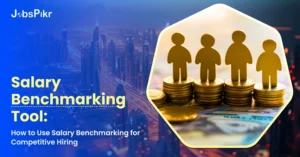Last year, the US job market saw tremendous growth in job opportunities while witnessing the lowest unemployment rate. As reported by Glassdoor, 76% of hiring managers have stated their biggest hurdle has been attracting top talent during recruitment. This doesn’t come as a surprise since the US unemployment rate in 2018 was at its lowest in almost five decades, according to the US Bureau of Labor Statistics. JobsPikr takes a look at all the top hiring trends going into 2019.
We believe this trend will maintain momentum in 2019 as well. This means that businesses will encounter an even larger challenge when it comes to hiring the best talent. In contrast to the earlier job market. The job seekers of the present time are in a commanding position, i.e. They are choosing their preferred employer, not the other way round.
So, what are the next big upcoming workplace disruptions? Glassdoor’s 2019 Job Market Trends Report discusses five critical job trends (some of which are already in play) and workforce disruptions that are going to have a huge impact on the way companies attract, hire, and retain talent.
This article will summarize the list of the top five employment trends that made a mark in 2018 and the upcoming disruption for 2019.
Data-driven job matching will be the norm in recruitment
Job matching has come a long way since the pre-internet era — from finding jobs in newspaper and sending resume to prospective employers to job aggregation and application via keyword search. However, the real disruption will be around the job matching via predictive recommendation engines driven by machine learning.
This stems from the fact that the job aggregator sites are not simply into collecting job listings from thousands of companies. There are employer review sites, networking platforms with humongous amounts of data on people, skills, companies, and jobs. By leveraging the availability of such data it would be quite natural for the recommendation engines to learn from job listings’ skill requirements and the job seekers’ skills, personality, and previous experiences to curate a small set of job opportunities with a higher level of accuracy in terms of matching.
This is going to be a win-win solution for both job seekers and employers. As it can make corporate recruiters much more productive via machine learning models to scour through the database for a list of best-fitting candidates. Apart from that, it improves the job search experience of prospective employees by helping them focus on a small list of jobs that can give a higher probability of final job offer along with culture-fit. These two factors will be combined to provide the right talent which would result in better employee engagement and retention.
AI will be augmenting workers’ skills
Last year, there was a swarm of articles debating the future of work in the post-AI era in which automation will be quite normal. According to Glassdoor, AI-driven automation of routine tasks will actually help the ‘knowledge-workers’ employed in the service industry (tech, consulting, finance, etc.) who use data, software, and intellectual skills to do their job.
Also, in a practical sense, the present job roles in various business functions comprise a complex set of tasks — some of which can be automated while others need human judgment. Hence, it understandable when experts say that automation will help workers become productive while taking care of repetitive tasks.
Now, the question arises: who’s currently hiring AI talent. According to the data provided by Glassdoor, major tech companies like Microsoft, Amazon, and NVIDIA are investing heavily in AI. But, we also see that a diverse set of industries starting from media and healthcare to finance and marketing have joined the AI bandwagon.
Given below is the chart that shows top US and UK employers hiring AI talent:
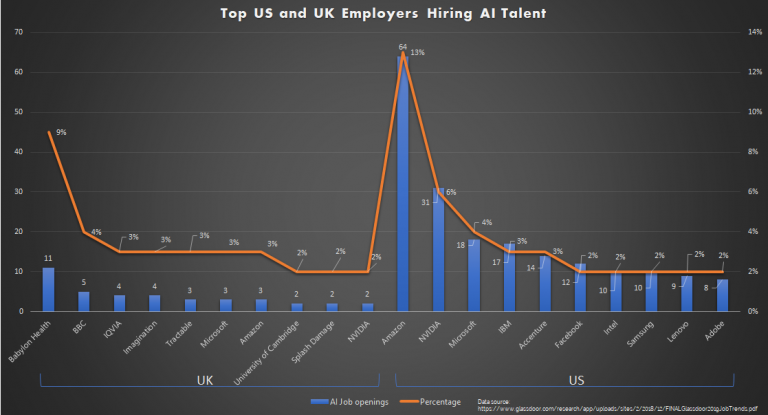
The report emphasizes that in the case of AI. The job roles are not limited to only tech jobs such as software engineering or data science. Many companies are hiring non-tech workers like product manager, sales manager, strategy consultant, copywriter. This brings us to our next topic in which we discuss the growing demand for non-tech workers.
The Expanding Tech Industry will be Hiring more Non-Tech Talent
During the early phase of the tech industry engineers, and technology architects built the infrastructure for the company’s software solutions. As the tech industry matures. Businesses would inevitably need sales and marketing talent to build the revenue pipeline from the company’s technology. Similarly, operations teams hire more as tech companies expand and set up new shops in various locations. Even software engineers require HR teams to manage benefits, payroll, and personnel issues.
This trend is already shaping up in the present time, as 43 percent of all open jobs at tech employers on Glassdoor were for non-technical roles. Here is the chart depicting open non-tech jobs in various companies and the percentage of non-tech jobs:
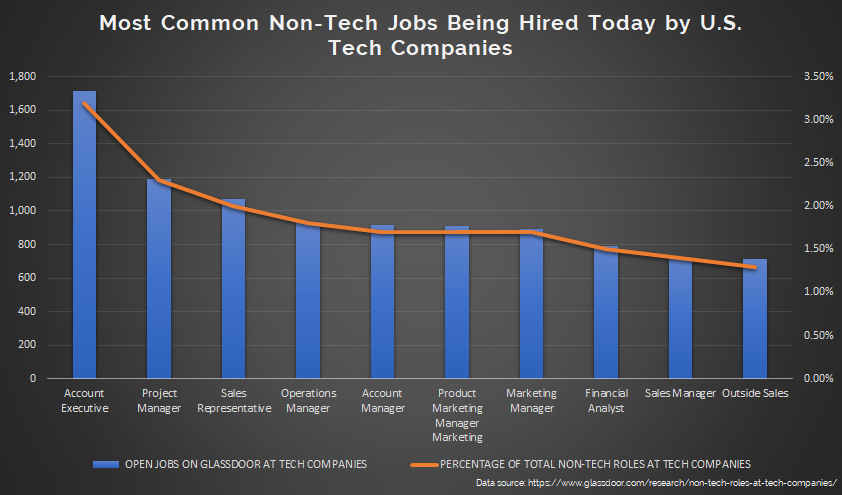
An important point to note from the report – non-tech hiring tends to rise with revenue. While the tech roles often grow more slowly. This is because of the fact that the technology platform can scale with user growth. But user acquisition and revenue scale happen with the growth in the number of sales personnel.
Aging Population will lead to Shortage in Talent Pool
Today the majority of the employers are plagued with a labor shortage. Glassdoor’s report suggests that one of the most influential trends arriving in 2019 and beyond is demographic changes, i.e. The slowdown in working-age Americans. This could lead to tight labor markets for several upcoming decades. The report says many present demographic trends are indicating towards aging, more slowly growing, and less work-focused American population. Similar to how a small tide can transform into a tsunami, these underlying demographic transformation will have far-reaching impacts on jobs, salary, and recruitment.
Here is the chart based on OECD data that shows the work-hour has been shrinking globally and the US is no different.
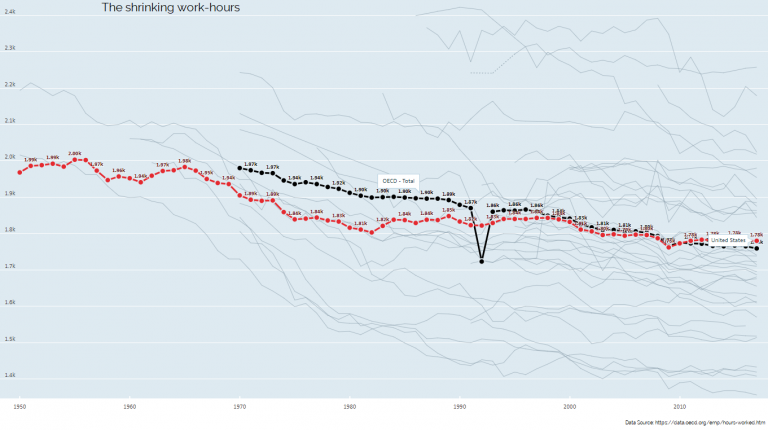
The first wave of Baby Boomers touched the retirement age of 65 in 2011 and millions more will follow the suit in the next few decades. That’s both reducing the nation’s pool of experienced workers and changing the age profile of American consumers. A falling birth rate, which reached a 30-year low last year, is one more cause that would result in a shrinking labor force. The rising demand from American consumers coupled with low growth in the working-age population would put employers in a difficult path.
The Looming Economic Slowdown
Companies in the U.S. have continuously added jobs for 99 months, the longest increment on record since the 1930s. However, fissures are the emerging economy — the Federal Reserve is increasing interest rates. This increases the cost of mortgages on a regular basis. The housing market is slowing and the 10 to 15 percent of the economy driven by trade is getting alarmed by the tariffs. The riskiness of corporate debt is increasing, with a record $3 trillion in low-grade corporate bonds today. The “yield curve” — the relationship between Treasury bond yields and maturity dates — is close to reversing its usual upward slope. A phenomenon that has generally been a good indicator of nearing a recession.
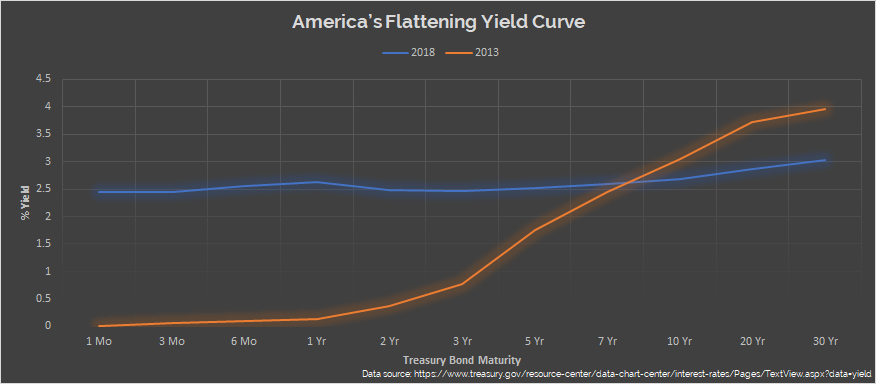
Another risk to watch is the dampening housing market. The Federal Reserve had increased interest rates three times in 2018. That has led to higher mortgage rates. This results in a gigantic increment in the cost of the housing making it out of reach for the majority of Americans. The final result is a slowing housing market. A major risk since housing is a huge industry and the main source of wealth for most Americans.
Although there are many economic risks on the horizon. By most studies today the odds of a recession in 2019 remain low and the economy overall is strong and healthy. According to Glassdoor – “As per the November survey of economists by Reuters. The median odds of a recession in the next 12 months have held steady at about 15 percent for the past year. Even over the next two years, the odds of recession according to that survey are about 35 percent — still very low.”


